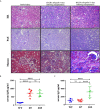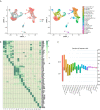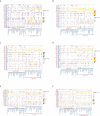Single-Cell RNA Sequencing Reveals the Immunological Profiles of Renal Allograft Rejection in Mice
- PMID: 34367152
- PMCID: PMC8340022
- DOI: 10.3389/fimmu.2021.693608
Single-Cell RNA Sequencing Reveals the Immunological Profiles of Renal Allograft Rejection in Mice
Abstract
Allograft rejection is a common immunological feature in renal transplantation and is associated with reduced graft survival. A mouse renal allograft rejection model was induced and single-cell RNA sequencing (scRNA-seq) data of CD45+ leukocytes in kidney allografts on days 7 (D7) and 15 (D15) after operation was analyzed to reveal a full immunological profiling. We identified 20 immune cell types among 10,921 leukocytes. Macrophages and CD8+ T cells constituted the main populations on both timepoints. In the process from acute rejection (AR) towards chronic rejection (CR), the proportion of proliferating and naïve CD8+ T cells dropped significantly. Both B cells and neutrophils decreased by about 3 folds. On the contrary, the proportion of macrophages and dendritic cells (DCs) increased significantly, especially by about a 4.5-fold increase in Ly6cloMrc1+ macrophages and 2.6 folds increase in Ly6cloEar2+ macrophages. Moreover, myeloid cells harbored the richest ligand and receptor (LR) pairs with other cells, particularly for chemokine ligands such as Cxcl9, Cxcl10, Cxcl16 and Yars. However, macrophages with weak response to interferon gamma (IFNg) contributed to rejection chronicization. To conclude, reduction in CD8 T cells, B cells and neutrophils while increasing in Ly6cloMrc1+ macrophages and Ly6cloEar2+ macrophages, may contribute significantly to the progress from AR towards CR.
Keywords: ScRNA-seq; acute rejection; chronic rejection; immunological profiles; renal transplantation.
Copyright © 2021 Shen, Wang, Chen, Ma, Huang, Tang, Lan, Jiang and Chen.
Conflict of interest statement
The authors declare that the research was conducted in the absence of any commercial or financial relationships that could be construed as a potential conflict of interest.
Figures












Similar articles
-
Single-Cell Transcriptome Analysis of Chronic Antibody-Mediated Rejection After Renal Transplantation.Front Immunol. 2022 Jan 17;12:767618. doi: 10.3389/fimmu.2021.767618. eCollection 2021. Front Immunol. 2022. PMID: 35111153 Free PMC article.
-
CD8(+)IL-17(+) T Cells Mediate Neutrophilic Airway Obliteration in T-bet-Deficient Mouse Lung Allograft Recipients.Am J Respir Cell Mol Biol. 2015 May;52(5):622-33. doi: 10.1165/rcmb.2014-0059OC. Am J Respir Cell Mol Biol. 2015. PMID: 25286244 Free PMC article.
-
Defective CD8 Signaling Pathways Delay Rejection in Older Recipients.Transplantation. 2016 Jan;100(1):69-79. doi: 10.1097/TP.0000000000000886. Transplantation. 2016. PMID: 26356176
-
Urinary Cell mRNA Profiles Predictive of Human Kidney Allograft Status.Clin J Am Soc Nephrol. 2021 Oct;16(10):1565-1577. doi: 10.2215/CJN.14010820. Epub 2021 Apr 27. Clin J Am Soc Nephrol. 2021. PMID: 33906907 Free PMC article. Review.
-
Dissecting the human kidney allograft transcriptome: single-cell RNA sequencing.Curr Opin Organ Transplant. 2021 Feb 1;26(1):43-51. doi: 10.1097/MOT.0000000000000840. Curr Opin Organ Transplant. 2021. PMID: 33315769 Review.
Cited by
-
Progress and applications of single-cell RNA sequencing and spatial transcriptome technology in acute kidney injury research.Mol Ther Nucleic Acids. 2025 May 30;36(3):102583. doi: 10.1016/j.omtn.2025.102583. eCollection 2025 Sep 9. Mol Ther Nucleic Acids. 2025. PMID: 40568028 Free PMC article. Review.
-
The cellular landscape of the normal kidney allograft: Main players balancing the alloimmune response.Front Transplant. 2022 Oct 17;1:988238. doi: 10.3389/frtra.2022.988238. eCollection 2022. Front Transplant. 2022. PMID: 38994377 Free PMC article.
-
Exosomes derived from LPS-preconditioned bone marrow-derived MSC modulate macrophage plasticity to promote allograft survival via the NF-κB/NLRP3 signaling pathway.J Nanobiotechnology. 2023 Sep 16;21(1):332. doi: 10.1186/s12951-023-02087-8. J Nanobiotechnology. 2023. PMID: 37716974 Free PMC article.
-
Multi-omics Approach in Kidney Transplant: Lessons Learned from COVID-19 Pandemic.Curr Transplant Rep. 2023 Dec;10(4):173-187. doi: 10.1007/s40472-023-00410-8. Epub 2023 Aug 23. Curr Transplant Rep. 2023. PMID: 38152593 Free PMC article.
-
Senescence-induced p21high macrophages contributed to CD8+ T cells-related immune hyporesponsiveness in kidney transplantation via Zfp36/IL-27 axis.Cell Discov. 2025 Apr 15;11(1):38. doi: 10.1038/s41421-025-00784-2. Cell Discov. 2025. PMID: 40234384 Free PMC article.
References
Publication types
MeSH terms
LinkOut - more resources
Full Text Sources
Medical
Research Materials
Miscellaneous

